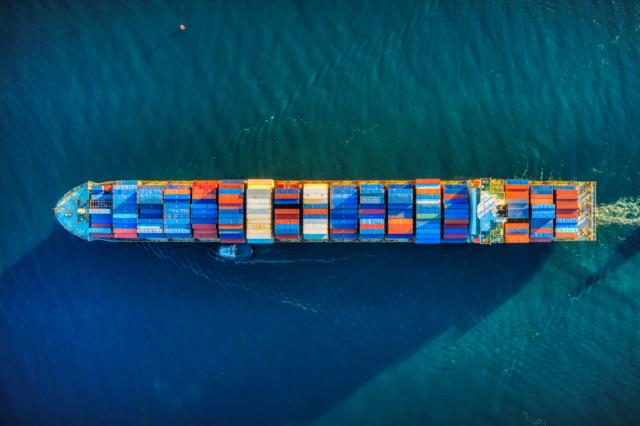
January 18, 2023
Landmark federal Blueprint targets widespread transportation decarbonization
By Elana Knopp, Senior Content Writer & Imani Love, Analyst, Transportation Electrification

Imani Love, an analyst on Edison Energy’s Transportation Electrification team, shares insights on the recently released U.S. National Blueprint for Transportation Decarbonization.
Love notes that decarbonization “starts and ends” with transportation, citing the importance of organizations working with partners like Edison Energy’s Transportation Electrification team to help them map out their routes to clean energy on the nation’s highways and byways. “As a team, we’re starting with vehicles, but as time moves forward and our expertise grows, our focus and efforts will expand beyond that to include micro mobility, boats, and airplanes,” she says. “You’ll come to us with a question, and we’ll bring you an answer with a clean and lasting solution.”
Last week, the Biden administration released the U.S. National Blueprint for Transportation Decarbonization, a landmark strategy aimed at cutting all greenhouse emissions (GHG) from the transportation sector by 2050.
The transportation sector accounts for a third of all domestic GHG emissions, while transportation costs are the second largest annual household expense in the U.S.
Developed by the Departments of Energy, Transportation, Housing and Urban Development, and the Environmental Protection Agency, the Blueprint builds on the Bipartisan Infrastructure Law (BIL) and the Inflation Reduction Act (IRA), which together represent historic investments in a more sustainable transportation system.
The Blueprint will be followed by a more detailed, sector-specific action plan, to be developed and implemented by these agencies in collaboration with state, local, and Tribal governments, philanthropic organizations, the private sector, and global partners.
“The Departments of Energy, Transportation, Housing and Urban Development, and Environmental Protection Agency essentially are all working towards the same goal – creating safe, healthy, and equitable environments – but each is tasked to look at it through a different lens,” said Imani Love, an analyst on Edison Energy’s Transportation Electrification team.
“If we are expected to achieve the Biden Administration’s 2035 and 2050 goals around decarbonization and clean energy, we must have representatives from each of these sectors in the same room having conversations.”
The Blueprint highlights the importance of deploying strategies that center equity and environmental justice in overburdened and historically underserved communities, which continue to bear the economic and health burdens of higher emissions, noise, and worsened air quality.
In addition, the plan calls for investments in low-carbon solutions to help build resilience and mitigate the impacts of climate change that disproportionately affect some communities.
“Addressing issues within transportation will inevitably influence energy, housing, and environmental issues, demonstrating the power of transportation within our society,” Love said. “We must prioritize this sector and make it one of the starting points in our journey to equity, affordability, and accessibility.”
 The Blueprint
The Blueprint
The federal Blueprint breaks the transportation sector into seven specific sub-sectors: light-duty vehicles, medium, and heavy-duty trucks and buses, off-road vehicles and mobile equipment, rail, maritime vessels, aviation, and pipelines.
Light-Duty EVs
With more than 280 million vehicles on the road, light-duty passenger vehicles (LDVs) -cars, SUVs, and pickup trucks – are responsible for about 50 percent of total transportation energy use and emissions.
Achieving 2050 net-zero emissions will require transitioning new LDV sales to zero-emission EVs by the mid-2030s, and then rapidly replacing the legacy stock of higher-polluting fossil-based vehicles with zero-emission EVs.
The Blueprint calls for:
- Implementing policy and regulation to expand market share and use of EVs
- EV charging infrastructure investments and planning
- Funding of research and innovation to improve vehicle, battery, and charger performance and to reduce costs
- Leveraging large investments from the BIL, IRA, and the CHIPS and Science Act to develop a domestic EV manufacturing supply chain
Medium- and Heavy-Duty Vehicles
While medium- and heavy-duty vehicles (MHDVs) represent only five percent of total vehicles on the road, they are responsible for an outsized 26 percent of transportation emissions, making them the second-largest emissions contributor behind light-duty vehicles.
While not currently commercially viable for freight applications, hydrogen vehicles are appealing for future long-haul operations requiring greater vehicle range and faster refueling times. There is ongoing RD&D and deployment focused on hydrogen use in internal combustion engines, which could improve deployment and support the buildout of hydrogen fueling infrastructure.
Sustainable fuels may also be an option for some MHDVs, particularly for remote applications and for legacy vehicles relying on internal combustion engines.
The Blueprint calls for:
- Funding research and innovation to develop viable technologies to replace fossil-fuel vehicles
- Implementing policy and regulation to reduce new vehicle GHG and criteria emissions and setting ambitious targets for transitioning to zero-emissions vehicles
- Investing in strategic demonstration and deployment to support the buildout of interoperable EV charging and refueling infrastructure
Off-Road Vehicles and Mobile Equipment
This category includes construction, mining, industrial, agriculture, and lawn and garden equipment, along with recreational vehicles.
Diesel provides the majority (79 percent) of the total fuel that off-road vehicles consume today, with gasoline, liquified petroleum gas, and compressed natural gas making up the remaining fuel consumption. Combined, off-road vehicles are responsible for 10 percent of transportation GHG emissions.
Strategies for decarbonizing the off-road sector will leverage technologies similar to other sectors, including battery electric and fuel cell EVs, and sustainable fuels.
The Blueprint calls for:
- Increasing targeted research and innovation efforts
- Implementing policy and regulations, including establishing GHG and efficiency standards for offroad vehicles and mobile equipment and setting ambitious targets for transitioning to zero- or low-emissions technologies
- Investments in strategic demonstration and supporting deployment through coordinated planning, policy, and funding opportunities
Rail
While electric rail technologies are widely used worldwide, freight rail carriers in the U.S. almost exclusively use diesel locomotives. Intercity passenger and commuter carriers also heavily rely on diesel, though there are some partially or fully electrified lines. Most rail systems that provide local public transportation, such as light rail and streetcars, are electrified but represent less than five percent of rail energy use.
The rail industry is currently exploring opportunities to maintain its comparative energy-use advantage on a ton-mile basis by transitioning to direct use of electricity, batteries, hydrogen fuels, sustainable fuels, or hybrid solutions.
Diesel alternatives for use in the U.S. freight rail industry are primarily in demonstration stages and not yet widely available, although there are interim opportunities to advance fleet technologies by retrofitting locomotives and using modular hybridization.
The Blueprint calls for:
- Infrastructure investments in electric locomotives and the expansion of electrification corridors to help accelerate the zero-emission transition
- Policy and regulation support
- Research and innovation to advance technology through pilot projects

Maritime Vessels
There are approximately 12 million privately owned recreational boats and 38,000 commercial vessels in the U.S. maritime sector. Recreational boats usually burn gasoline, while larger vessels rely on an almost equal share of diesel and residual oil, the latter of which is generally used for international voyages.
According to EPA estimates, half of U.S. marine vessel carbon emissions come from international shipping, roughly 30 percent from domestic shipping, and the remaining 20 percent from recreational boats.
Efforts are underway globally to significantly reduce the GHG emissions of vessels and port activities. There are currently several viable energy-efficient technologies, including battery electrification options for smaller vessels and recreational boats, and in-port shore power using clean, onshore energy sources.
Promising fuels and technologies that can support maritime decarbonization include certain types of biofuels, ammonia, hydrogen, and methanol, while electric powertrains and batteries can be used to augment power on certain vessels.
The Blueprint calls for:
- Research and innovation on viable alternative fuels and new technologies
- International and domestic stakeholder engagement to develop and implement effective decarbonization strategies and regulation
- Infrastructure investments and improved design and planning across clean technologies and fuels for maritime applications funded through new and existing federal programs
Aviation
The combustion of jet fuel from domestic and international aviation is responsible for more than 10 percent of total transportation GHG emissions in the U.S. Notably, the CO2 emissions from domestic commercial flights are roughly comparable to the CO2 emissions of international commercial flights coming to and leaving from the U.S.
Sustainable aviation fuels (SAFs) will be critical to the long-term decarbonization of aviation. SAFs are fully interchangeable, drop-in liquid hydrocarbon fuels with the same performance and safety as conventional jet fuels produced from petroleum. SAF production will be aided by the new tax credits and a competitive grant program established by the IRA. In addition, battery electrification and hydrogen fuel are potential options for replacing petroleum-based aviation fuels.
Since the majority of aviation CO2 emissions stem from long-haul operations and fleet turnover is slow—an average of 30 years for most aircrafts— drop-in SAF is the most viable pathway for rapid decarbonization of the aviation sector.
The Blueprint calls for:
- Policy and regulation to incentivize low-emission aviation innovations through new and breakthrough technologies
- Reducing emissions by providing access to and use of proven technologies from other transportation sectors
- Research and innovation to advance technological, operational, and sustainable aviation fuels solutions to reduce emissions
- Pursuing ambitious international standards that incentivize effective technologies
Pipelines
Approximately 3.3 million miles of pipelines transport natural gas and petroleum throughout the country. Natural gas and petroleum represent 32 percent and 37 percent of total U.S. energy usage today, respectively.
Generally, these pipeline systems offer an efficient method of transportation; however, the fossil fuels they move are a major source of U.S. GHG emissions. The energy used to move products through pipelines is responsible for approximately 4 MMT of CO2 emissions per year – plus the emissions associated with generation of electricity.
Moreover, pipeline leaks and failures can release methane into the environment.
While pipelines primarily transport fossil fuels today, future sustainable energy system pipelines could potentially transport CO2 to injection wells for carbon capture and sequestration and to other end users. They could also be used to transport hydrogen and other sustainable liquid fuels like SAF.
The Blueprint calls for:
- Policy and regulation that increase the stringency of methane emissions limits, tackle emissions associated with pipeline operations, and promote the viable use of electricity or other clean energy sources
- Infrastructure investments and improved design and planning for pipelines, made possible through provisions in the BIL
- Research and innovation to develop tools and reporting systems for accurate disclosure of methane emissions
“Transportation greatly affects how humans live, work, and play and we cannot continue to move forward with proper and impactful sustainability planning without these sectors being on the same page, or at the very least understand how they can work with another to move towards decarbonized transportation,” Love continued. “These departments are co-dependent on each other – that’s why this agenda is monumental.”






